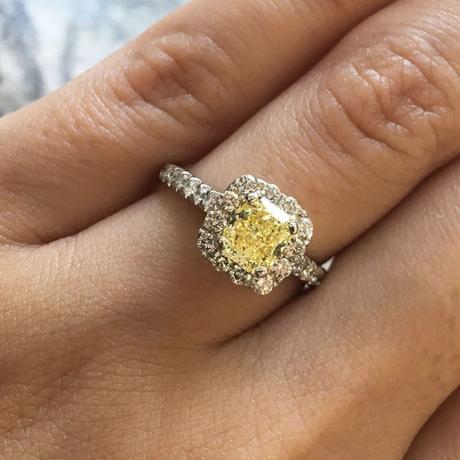Hey hey hey! Irradiated diamonds are NOT a mutant strain of diamonds caused by radioactive spider bites or alien planet elements despite their name. It’s important I clear that up right away. They are, however, a point of strife and division in some spheres of the jewelry industry and can be abused (like anything, really) by unscrupulous jewelers. But I’m getting ahead of myself and neither Diamonds by Raymond Lee nor Raymond Lee Jewelers are unscrupulous so I’m just going to spit straight irradiated diamond facts today, okay?

This Neil Lane halo engagement ring is actually a natural fancy yellow, but if it was irradiated, would you be able to tell?
So if they’re not Spiderman…
Irradiated diamonds are natural diamonds that have been treated to enhance their color. They aren’t lab created, they’re grown in the earth over billions of years. Once they’re mined, cut and polished, they undergo irradiation to brighten up the presence of any hint of color.
The process of irradiation itself involves the diamond first being exposed to strong radioactive treatment (it becomes harmless almost immediately after this step. You won’t grow an extra finger.) Then the diamond is heat-blasted (technical term ((not really)) to produce an even more dramatic brightening of color.
Um, are they radioactive?
Nah. Every diamond is exposed to some radiation deep within the earth as they form. These stones are just exposed at a higher level to produce a beautiful color that you’d otherwise pay a lot more for.
Ok cool, let’s talk more about the heat.
Because the heating step in the irradiating process produces that final color change, some irradiated diamonds may change again if the stone is exposed to extreme heat again. The diamond won’t turn white (or near colorless) but it will lose some of its original vibrancy if this happens. So it’s always important to tell anyone working on your jewelry for repairs that the stone is irradiated.
How will I know if the diamond is irradiated?
This is an excellent question. You will know you’re looking at an irradiated diamond because you only shop with jewelers you trust who believe that disclosing treatments is vital to their integrity. Because it is.
Disclosure is the most important part of selling treated diamonds!
Irradiated diamonds are natural stones, so they look like untreated fancy colors. They have the same refractive index, they have the same range of fancy colors (blue, green, pink, and fancy yellow) and the GIA will grade them.
If the stone is GIA certified, you can breathe easy. They will specify the treatment on the cert and can laser inscribe the stone to let buyers know it’s irradiated.
The color will look a lot like a “fancy intense” grade of its naturally colored cousin. The price, however, should be a fraction of the cost of the exceedingly rare fancy intense colors found in nature. Again, a reputable jeweler will price these stones fairly and disclose that they’re treated, passing the savings along to you.
So I’m going to get a Beyonce-caliber diamond for pennies on the dollar, yes?
Kind of. The irradiation process will enhance a color on a diamond, so your rock will be flawless color-wise, but may not be Flawless clarity-wise (which is the primary criterion for Beyonce’s diamonds.) The process doesn’t change the overall clarity grade, doesn’t remove inclusions, and doesn’t disguise blemishes.
Irradiated diamonds are a great way to get the fancy colored look for less while sticking to genuine, natural diamonds. Especially if you want a super rare fancy color like blue or green. We just got a whole collection of them in the showroom, so you can expect to see more of them on our Instagram feeds. And if you have any questions, please comment, tweet, e-mail me, or send me a lovingly hand-lettered postcard.

